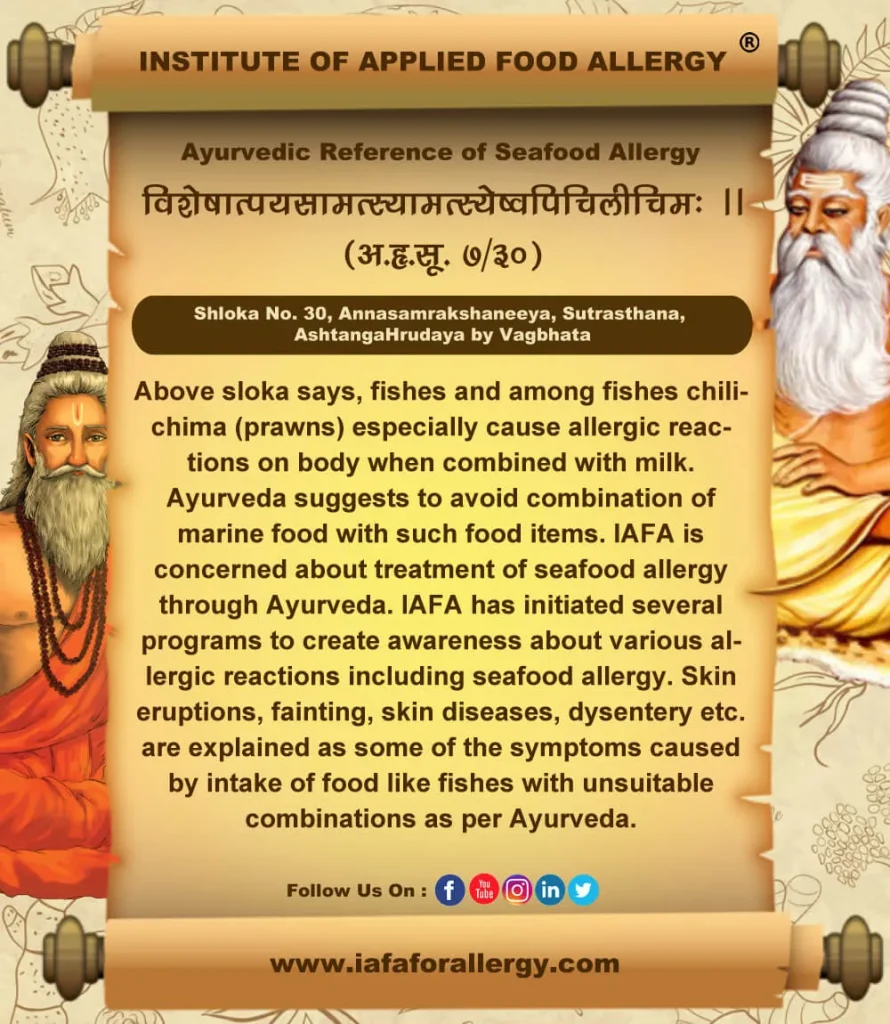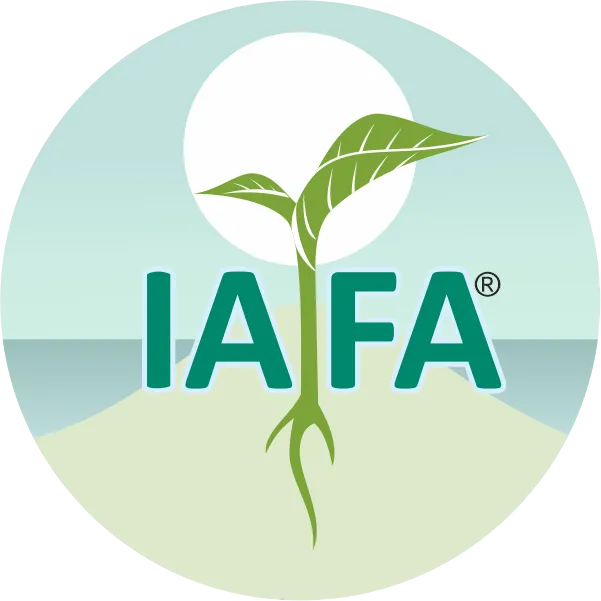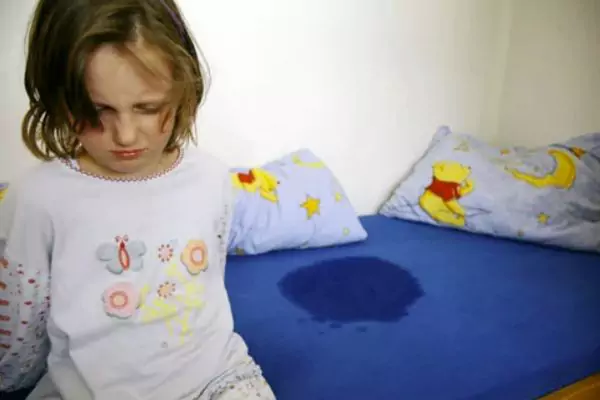On This Page
Seafood Allergy – Causes, Symptoms and Ayurvedic Treatment
विशेषात्पयसामत्स्यामत्स्येष्वपिचिलीचिम: ।।
Seafood Allergy is the hyper-reaction of the body towards certain eatable organisms available from the sea. Shellfish is the most common type of seafood that causes an allergic response. Seafood Allergy is more common in adult women. Symptoms vary from mild to life-threatening. In Ayurveda, Matsyavarga (Group of fishes) is mentioned. These are said to cause adverse reactions in the body usually when combined with some mismatched foodstuffs.
Causes of Seafood Allergy
The proteins present in some seafood are misidentified as harmful substances by the body’s immune system and produce antibodies to expel them. Next time, when the body is exposed to this protein again, these antibodies readily stimulate the production of histamines that initiates the body’s immune reaction. Shellfish is the most common category of seafood responsible for allergic reactions. Shellfish is of different types each containing different types of proteins. Two major types of shellfish are Crustaceans and Mollusks. Crustaceans include crabs, lobster, prawns, etc. and Mollusks include squids, snails, oysters, etc. Some people may be allergic only to some types of shellfish while some others are allergic to all types.
Ayurveda suggests the use of certain marine foods joined with other foods like black gram, milk, honey, jaggery, etc. results in adverse reactions.
Symptoms of Seafood Allergy
Allergic response towards seafood may be manifested within minutes to one hour of exposure. Symptoms include:-
- Rashes and itching on the skin
- Wheezing, and breathing difficulties
- Nasal congestion
- Abdominal pain
- Nausea
- Vomiting
- Diarrhea
- Dizziness
- Fainting
In severe cases, allergic reactions can result in anaphylaxis which may require a medical emergency.
Skin eruptions, fainting, skin diseases, dysentery etc. are explained as some of the symptoms caused by intake of food like fishes with unsuitable combinations.
Ayurvedic Reference of Seafood Allergy (Matsyavarga)


“Dr. Gupta’s IAFA is extending our hands to help all, who are suffering from occupational allergy, through Ayurveda. Ayurveda ensures tremendous relief from allergic diseases and IAFA is the paramount door to spread the grace of Ayurveda to all”.
Reach IAFA for real Ayurvedic healing!!!
– Dr. Sahil Gupta (B.A.M.S., M.H.A.)
Ayurvedic Allergy Specialist
CEO & Founder of IAFA®
At last, Easier Seafood Allergy Management

Trusted by
More than 90,000 Patients

Convenient
at-Home Treatments

9.2 / 10
Customer Satisfaction Score
Ayurvedic Treatment of Seafood Allergy
Ayurvedic medicines help to reduce the intensity of symptoms caused by seafood allergies and to avoid severe complications. Ayurveda advocates both purification therapy and pacifying medicines in the management of allergic conditions.
Internal Medicines for Seafood Allergy
Following internal medicines can be advised according to the condition of the patient:-
- Guduchyadi kashaya
- Patoladi kashaya
- Amritarajanyadi kashaya
- Vilwadi gulika
- Dasamoola haritaki lehya
- Punarnavadi Kwatha
Purification Therapies in Seafood Allergy
- Virechana (Purgation)
- Vamana (Emesis)
- Raktamoksha (Blood-letting)
Single Herbs in the Management of Seafood Allergy
Single Herbs for Seafood Allergy Ayurvedic treatment are Amalaki (Phyllanthus emblica), Raktachandana (Pterocarpus santalinus), Katuki (Picrorhiza kurroa), Yashtimadhu (Glycyrrhiza glabra) and Khadira (Acacia catechu).
Diet Management in Seafood Allergy
Pathya (Do’s)
- Light and compatible food
- Freshly prepared food
- Gooseberry
- Pomegranate
- Practice of exercise
- Adequate sleep
Apathya (Don’ts)
- Repeated use of allergic food
- Excess consumption of Alcohol
- Regular intake of seafood
- Use of milk and milk products along with seafood
- Junk food
- Reheated and old food
- Use of cold water
Yoga and Pranayama in Seafood Allergy
Yoga helps to attain physical and mental strength that in turn elevates immunity of body. Following Yoagasanas will be beneficial for people having seafood allergies:-
- Suryanamaskar
- Padahasthsana
- Matsyasana
- Bhujangasana
- Pavanamuktasasana
Pranayama (breathing exercise) will help to open up body channels and to relieve stagnant body functions by allowing free movement of Vata dosha.

Frequently Asked Questions
Question: What is seafood allergy?
Answer: Seafood allergy is the hypersensitivity reaction of body’s immune system towards certain proteins in seafood.
Question: What are the major symptoms of seafood allergy?
Answer: Symptoms of seafood allergy include nausea, vomiting, diarrhea, abdominal pain, etc.
Question: How does Ayurveda manage symptoms of seafood allergy?
Answer: Ayurveda treats with internal medicines that reduce the body’s adverse effects and purification therapies that expel accumulated impurities from the body.
Dr. Gupta’s IAFA is the leading institution in the management of various immune related disorders. IAFA is the most reliable institution that provides ultimate Ayurvedic treatment for your illness.
IAFA holds your hand to wellness!!
Was this Page Helpful?
So IAFA Ayurvedic Management of Seafood Allergy is just 3 steps away!

01. Connect With Us
Share your history of illness or Book your appointment

02. Consult With Us
Dr. Gupta a certified Ayurvedic Allergist Consultant

03. Root Cause Treatment
Get an accurate diagnosis, medicines, diet & lifestyle change
Real Case Studies – Successfully Treated Patients
Real Case Studies of Successfully Treated Patients from All Around the World by IAFA Ayurveda®

5-Year-Old Shih Apso Dog Recovered from Canine Peripheral Neuropathy – A Case Study
This case study presents a 5-year-old Shih Tzu-Lhasa Apso crossbreed dog (pet)…

9 Year Old Female Patient Recovered from Chronic Allergic Bronchitis – A Case Study
This case study presents a 9-year-old female patient who has successfully recovered…

12-Year-Old Child Recovered from Sun Allergy and Polymorphous Light Eruption (PMLE) – A Case Study
This is a case study of a 12-year-old child who has successfully…

40-Year-Old Female Patient Recovered from Dyshidrotic Eczema and Onychomycosis – A Case Study
This case study highlights the successful recovery of a 40-year-old female patient…
Read More Articles

Bed Wetting (Shayyamutra)
Bedwetting is an embarrassing habit in some children where they are unable…

Attention Deficit Hyperactivity Disorder – ADHD (Vatika Unmada)
Contact IAFA Ayurveda® to get safe and natural remedies for the treatment…












